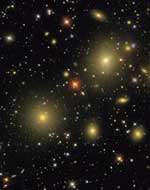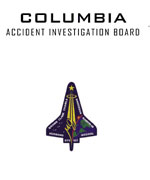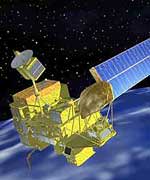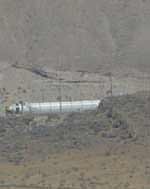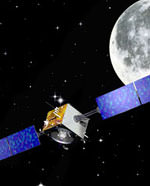
Image credit: ESA
The European Space Agency’s SMART-1 spacecraft has been orbiting the Earth for a full month now, and has made 64 complete orbits. Engineers have been wary this week about firing its ion engine with the increased solar activity. There have been a few problems: the engine unexpectedly turned off, but worked fine on the next firing; its star tracker had difficulty orienting the spacecraft but upgrades to the software resolved that. It’s still on track to reach the Moon by March 2005.
The spacecraft is now in its 64th orbit and has been flying in space for one month! The main activity of the last week was to continue the thrust firings of the electric propulsion engine in order to boost the spacecraft orbit. This operation was limited due to problems with the local radiation environment as a result of the recent, high intensity solar activity. The engine has now generated thrust for a total cumulated time of about 300 hours.
Despite the rather short thrusting phase, the electric propulsion engine performance has been periodically monitored as usual by means of the telemetry data transmitted by the spacecraft and by radio-tracking by the ground stations. We noticed that the EP performance is still improving. From the original expected underperformance of about 3%, we went to last week?s slight over-performance of about 0.5% and we now have an engine that gives about 1% higher thrust than expected. This confirms our confidence in the excellent conditions of the electric propulsion system.
In this period we have also experienced an autonomous shut-down, or flame-out, of the engine. This happened on 26 October 2003 at 19:23 UTC, a few hours before a scheduled switch-off. The engine then re-ignited autonomously at the next scheduled thrusting restart without problems. The experts are investigating the problems. One curious coincidence is that at exactly the same time the radiation monitors on two ESA scientific spacecraft in highly elliptical orbits (XMM and Integral) had detected considerable radiation coming probably from a solar flare. This event was so large and potentially dangerous that one instrument on board Integral stopped operations and switched itself in to safe mode.
The electric power provided by the solar arrays has been according to predictions – about 1850 W for this phase of the mission. The power degradation, due to the radiation environment, was also less than expected at 1-1.5 Watts per day. Recently however, starting from October 20, we noticed a sharper degradation of the power, probably due to the increased radiation environment.
The communication, data handling and on-board software subsystems have been performing according to expectations so far. We are also detecting signs of an increase in the local radiation environment. An onboard counter records the number of hits produced by charged particles, like protons or ions, which cause a single bit in the digital circuits of the computer memory to change state, known as a Single Event Upset. We noticed a sharp increase in the count rate from 23 October onwards. This is currently attributed to the increased solar activity.
The thermal subsystem continues to perform well and all the temperatures are as expected. During the last period the spacecraft systems coped very well with a partial lunar eclipse, where the Moon obscured about 70% of the solar disk for around 80 minutes. Although the average spacecraft equipment temperature has not changed much during the mission, some equipment is experiencing temperature fluctuations due to changes in both the spacecraft’s attitude along its orbit and the Sun’s position. The angle between the Sun direction and the orbit line of apses (the line joining the perigee and the apogee) has changed considerably during the mission. It has varied from about 16 degrees at the beginning of the mission to a current value of 35 degrees. This change could be responsible for the increase of the star tracker optical head temperature during part of the orbit. As the Sun gets further away from the line of apses, this effect should be attenuated and the star tracker conditions should improve.
The attitude control subsystem continues to work, in general, very well. The main area of concern in this period has been the star tracker. This advanced autonomous star mapper has failed in the last two weeks to provide good attitude information in a few cases during different parts of the orbit. We have now found the explanation for all cases. It is due to a combination of several effects. The dominant effect is the increased background radiation level, especially protons to which the star tracker CCD is sensitive. This effect, combined with the temperature increase of the star tracker optical head in some parts of the orbit, created ‘hot spots’ in the CCD which were mistakenly interpreted as stars. This problem has been corrected by a software change uploaded to the star tracker computer.
Another problem was caused by the high star richness of some areas of the galaxy where the star tracker is pointing during part of the orbit. Too many stars require a computer processing time in excess of the allocated slot and cause ‘drops’ of attitude determination. The third problem was the blinding that the Earth disk produces to the optical head. These problems have been corrected by modifications to the software of the star tracker, which has been successfully updated onboard. Since these corrections have been made, the star tracker has been working very well and no further drops in attitude determination have been observed.
Original Source: ESA News Release



